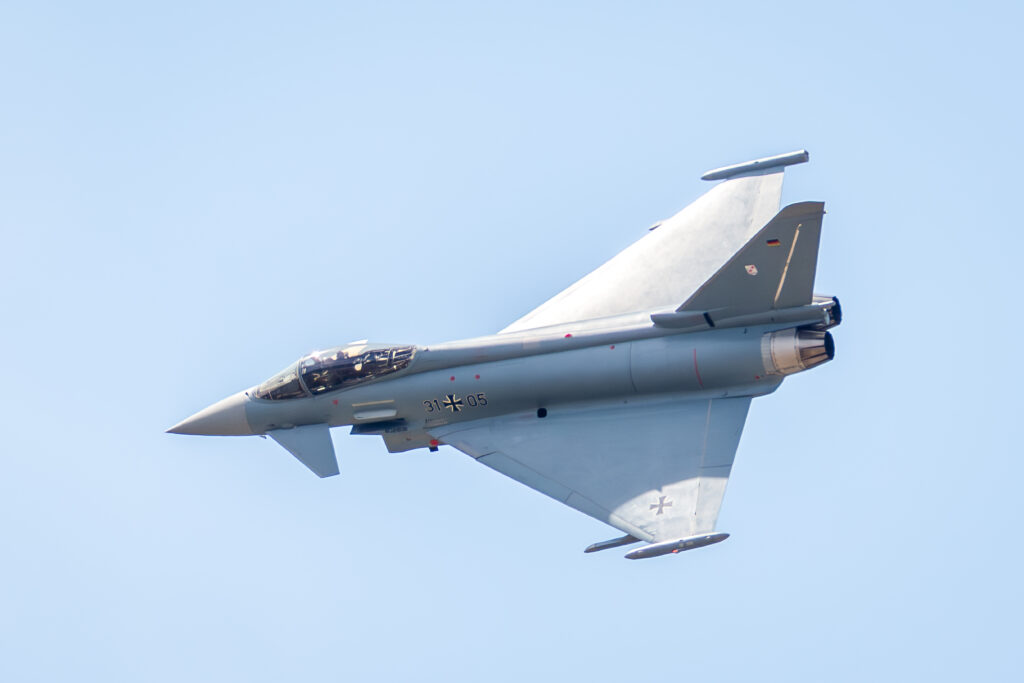Analyses / Observatory of Turkey and its Geopolitical Environment
25 November 2025
Sale of 20 Eurofighters to Turkey: Context and Industrial and Political Consequences

On 27 October 2025 in Ankara, the President of the Republic of Turkey, Mr Recep Tayyip Erdoğan, and the British Prime Minister, Mr Keir Starmer, signed an agreement for the sale of 20 Eurofighter Typhoon fighter-bombers. The first deliveries are scheduled for 2030.
The value of the contract differs depending on whether the source is Mr Starmer or the spokesperson of the Turkish Ministry of National Defence. For the former, it amounts to 10.7 billion dollars, including economic returns within the British ecosystem and future options whose details are not yet known. The latter aligns with a statement by BAE Systems, the project’s prime contractor, which mentions 5.4 billion pounds sterling (around 7 billion dollars) covering the serial production of 20 brand-new, latest-generation aircraft (Tranche 4[1]), as well as the sale of pods, Meteor air-to-air missiles, and Brimstone air-to-surface missiles.
At the same time, Turkey is in talks with Qatar and Oman for the purchase of 24 second-hand Eurofighters, 12 from each country, which would bring the total number of these aircraft in the Turkish Air Force to 44. An option to purchase an additional 20 new aircraft has been mentioned, although it has not been clarified whether these would be added to, or would replace, the 24 second-hand aircraft.
Why a purchase of Eurofighters?
The Turkish Air Force operates around 250 fighter-bombers: just under 20 F-4E Phantom Terminator 2020s and 234 F-16C/D Fighting Falcons. The F-4Es are extremely old (the aircraft’s first flight took place on 27 May 1958), even if they have been modernised through the Simşek and Işik programmes. As for the F-16s, they are no longer of the latest generation. As a result, the renewal of this fleet was essential in order to halt the decline of the Turkish Air Force, not only within NATO, but above all in relation to Greece, which is now equipped with the French Rafale and, within a few years, the American F-35/JSF.
Could the Turks have turned to the United States? Having joined the American F-35 programme in 1999 as a level-3 partner[2], with the intention of acquiring a minimum of 100 aircraft, Turkey was removed from the industrial partnership on 17 July 2019 because of its purchase of Russian S-400 surface-to-air and anti-missile systems. Ankara then decided to accelerate its national fighter aircraft programme, the TF-X/Kaan, launched three years earlier on 5 August 2016. However, even the most optimistic statements by Turkish manufacturers foresee delivery of the first aircraft in 2028 in the current development phase, with deadlines constantly being postponed. Furthermore, the first Kaan aircraft entering service will have only minimal combat capability (a kind of “Block 10”) and, which is a major obstacle to the strategic autonomy sought by Ankara, will not yet be equipped with a national engine. Faced with the unavoidable timescale for technological build-up, Ankara regularly puts pressure on Washington to reintegrate the F-35 programme, but without success at this stage, despite the public optimism expressed by Turkish political authorities. Indeed, despite the supposedly good relations between Presidents Trump and Erdoğan, relations between Turkey and the United States have not yet stabilised: CAATSA sanctions[3] are still in place and continue to block the export of Turkish T-129 attack helicopters to Pakistan. Moreover, negotiations for the purchase of 40 F-16 Block 70 VIPER[4] aircraft by Ankara are not progressing.
What other choices, then, were available to Ankara? Acquisition of the Rafale was not feasible given the state of Franco-Turkish relations: mutual confidence has still not been restored (too many divergences remain on issues such as Nagorno-Karabakh, Libya and Syria), and Paris wishes to maintain good relations with Athens in a context of deliveries of multimission frigates and ongoing discussions for defence and intervention frigates. The Swedish Gripen is a capable aircraft sold to several countries worldwide, but it is not the 5th-generation fighter that Turkey is seeking. China and Russia therefore remained the only other countries in the world capable of offering an operational 5th-generation aircraft, but it is likely that Turkey’s removal from the F-35 programme following its acquisition of S-400 systems deterred Ankara from considering any non-European or non-NATO option. The only remaining solution was the Eurofighter.
Turkey’s interest in this aircraft is not new. It dates back to the 1990s, when it was still under development and had not yet made its first flight. At that time, talks between Ankara and the Eurofighter consortium (Germany, Spain, the United Kingdom and Italy) were frequent, but did not materialise due to contract specifications and, above all, acquisition and maintenance costs. But Turkey’s return to the European consortium to negotiate the purchase of the aircraft was not straightforward: efforts were required to overcome the German obstacle, mainly linked to disagreements over respect for the rule of law in Turkey. This issue was resolved on 23 July 2025.
What are the industrial and political consequences?
From an industrial and financial standpoint, the sale of new aircraft to Turkey is a boon for the Warton production line in the United Kingdom, which is currently almost idle. More broadly, it is a boost for the Eurofighter programme, which is facing a decline in orders, high maintenance and upgrade costs, and growing competition from the Rafale. It also provides financial inflows that help absorb uncertainties regarding the future of the SCAF (Future Combat Air System) programme, in which Germany and Spain participate, and Tempest, a 6th-generation fighter programme launched by the United Kingdom with input from Italy.
Politically, this concerns the sale of 5th-generation fighter-bombers to Turkey, a country that is not a member of the European Union, at a time when strengthening the military capabilities of European countries is considered urgent and vital. It therefore raises questions about the willingness and ability of EU countries to equip themselves with European matériel and, in this respect, invites reflection on Turkey’s possible participation in the SAFE mechanism (Security Action for Europe).
In any case, the sale of the 20 Eurofighters from the United Kingdom to Turkey forms part of a “win-win” process. For Turkey, it is another step towards building an autonomous defence industry, as it is highly likely that the contract will involve technology transfers, especially if, as suggested by certain political statements, joint manufacturing of aircraft and the integration of Turkish national munitions are envisaged. For the United Kingdom, the Labour Prime Minister can only welcome the economic benefits, with the creation of 20,000 jobs according to his statements. In all cases, both parties highlight the strategic Turkish-British relationship as an example, emphasising that it contributes effectively to strengthening NATO’s capabilities.
[1] “Tranches” refer to the phases of the aircraft’s development. Tranche 1: initial development with limited air-to-air combat capabilities; Tranche 2: multirole capability with the addition of air-to-surface capacities; Tranche 3: upgrade with integration of advanced capabilities; Tranche 4: evolution of the aircraft to meet future combat requirements (integration with drones, operations in complex environments, etc.). Tranche 4 is currently under way.
[2] Level-1 partner: the United Kingdom only (major industrial influence); level-2 partners: Italy and the Netherlands (contributing to development but to a lesser extent than the UK); level-3 partners: Australia, Denmark, Norway, Canada and Turkey (more modest contributors).
[3] Countering America’s Adversaries Through Sanctions Act.
[4] Latest version of the F-16 (Block 70/72), which would enhance the operational capacity of the Turkish Air Force while awaiting the entry into service of the Kaan.

